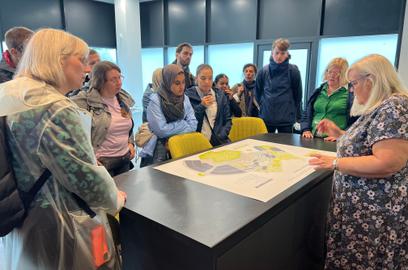Getting the best from your briefs

Tibbalds
I recently made the move into town planning’s private sector after many years working on the public sector side for various local authorities, built environment charities, quangos and regeneration agencies.
I expected a change of culture in many ways and there is no doubt that, culturally, the private and public sectors are very different, though the commitment of people to the work that they do within their environment is not. However, my emotions and feelings about the move are fluid and quick changing as I combine the thrill of exploring the range of projects I’m now getting involved with against the sense that I still must find my place and make my mark in a completely new environment. Both are like spinning and swirling in a fast river and I’m looking about for that place to cling to and enjoy the ride.
However, one area of work has already struck me as being very differently perceived between the public and private sector; tendering and procurement. It seems to me that there are some misunderstandings on both sides here and some better understanding could make the process smoother.
Budget
From a public sector side, I always felt that the budget – unless defined through a committee paper or similar – was something of an open question. Within planning teams, money would be tight for projects and caution was the order of the day, but if work needed doing, funds could be found for the right consultant. In writing briefs, I always felt a little cagey about the budget, as though the brief was an exercise in finding a consultant, but also an exercise in working out what the work was and what might be achieved out of it from a long list of potential desires.
On this private sector side, I have found that a discussion about whether to respond to a brief rests on two things, one of which is an understanding of the budget available (more of the other in a moment). Briefs vary wildly in their quality and precision about the work being discussed and very few seem to set out a clear idea of the budget available to achieve it. This leaves those reading the brief unclear as to where quite to pitch the work, unclear on what sorts of skills a project requires and uncertain as to how to weight various inputs. Even a small misreading of these things can lead to a huge difference in the fee that might be offered.
Recently, I was presented with a brief for which no budget was defined. The geographic scope of the work was also ambiguously defined which made pitching a response difficult. During a clarifications period, I asked what the budget was; the answer came back that there was no budget set, but there were sufficient funds to cover it. This clarification did not help.
In some cases, the public sector body may approach a consultant with a draft brief and offer comments and clarifications on it before a final issue. This undoubtedly helps to more precisely define the work and will bring better, more competitive responses.
Invitees
Many briefs come our way as open tenders, which means anyone can respond to them. Some are limited to a panel, though the panels can also have a high number of possible consultants on it. The second consideration in whether it may be worth responding to a brief is who else may be responding to it. A large pool limits the chance that any response will be successful.
Whilst in the public sector, I wrote a brief for project to which many planning, architectural and urban design consultancies would be suited. The importance of the work meant that political input was sought to the content of the brief but it also guided the long list of companies to which the brief was to be sent. The final list of over twenty firms was designed to try to attract the attention of a ‘big name’ practice and there was much excitement and anticipation about who might respond. The result was a small number of responses, with none from those who were considered (politically) to be the biggest names.
From the private sector perspective, a view has to be taken about the possibilities of getting the work. If the brief is well defined and in our area of work, a smaller list of invited consultants will result in a greater chance of a response being prepared. If there is an open tender, or a long panel list, the likelihood is that no response will be prepared because of the time and effort involved in preparing a response.
Time and effort
As a public sector employee, deadline day was the most anticipated day of the tender process; who was going to respond and what were they going to offer? I would be looking for a clear response to the brief, place specific and nicely illustrated and explained. If there were a number of returns, brevity and clarity would be welcome as there would often be more than one response to read, understand and evaluate. I would be impressed if the consultant had clearly visited the site or the project location, taken good photographs and / or prepared some initial thoughts. I would be dismissive of elements that were cut and paste into a response (especially those that refer to some other place) or included images and text that were out of date.
I rarely gave much thought to the time and effort required to pull a response together. Now on the other side, I have a greater appreciation of the work involved. In the three months I’ve spent in the private sector, I have read almost fifteen briefs that have required some detailed examination, over half of which were submitted.
A single brief often takes two or three people a week or more to put together and often involves a good understanding of the brief, a process of clarification of unclear elements, a policy review, a site visit, some analysis, preparation of a methodology, perhaps the identification and co-ordination of sub-consultants, preparation of CVs, collation of project examples, a programme and resource sheet, company legal and financial information, other eligibility criteria and possibly further information. Briefs are not issued in a standard way, so every response needs to be carefully examined to determine the correct means of submission (whether by portal, via email or in hard copy) in the right format (whether in a single pdf document or through a series of separate uploads on pre-defined forms and tables). Our team has become skilled at dealing with these different means and methods, but it always requires care and attention and always a bespoke response. One needs to avoid the possibility of disqualification simply because an eligibility criterion was missed or the response is prepared in the wrong font or at the wrong point size; such is the precision of what is often defined.
Because of the time and effort involved, it is easy to see why a clear brief with a good idea of budget and a targeted list of invitees for the work makes a real difference to the consultant considering the brief.
The message is clear. The public sector will receive better bids for work from the right consultants if they have a well-defined brief with a sensible timescale and a good idea of what they have to spend. The private sector will respond enthusiastically to work that is within their expertise, for which they can properly resource and respond to and for which they have a reasonable chance of securing within a targeted range of possible consultants.
Richard Crutchley is an Associate at Tibbalds Planning and Urban Design.
Topics:
Related Updates

Bristol Study Trip

Tibbalds
Stay In Touch
Sign up to our Newsletter
Subscribe to our newsletter to receive updates about making people friendly places.


